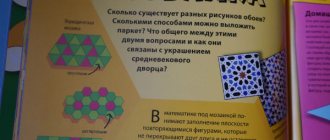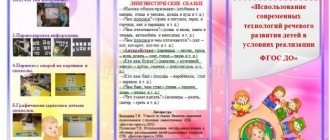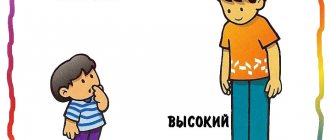MAGAZINE Preschooler.RF
Creating a center for speech development in a group is an important factor in the cognitive and speech development of children.Author:
- Solovyova Svetlana Leonidovna. Teacher of MBDOU D/s No. 52 “Belochka” , Yakutsk
One of the leading tasks that preschool educational institutions solve is the development of children's speech. Speech, as the leading means of communication, accompanies all types of child activity. From the quality of speech, the ability to use it in a game, during joint activities between a teacher and a child, when planning and discussing a drawing, in observing a walk, when discussing a performance, etc. depends on the success of a child’s activities, his acceptance by peers, his authority and status in the children’s community.
According to the Federal State Educational Standards, the content of the educational field “Speech Development” is aimed at achieving the goals of developing oral speech and verbal communication skills with others based on proficiency in the literary language of one’s people.
The richer and more correct a child’s speech, the easier it is for him to express his thoughts, the wider his opportunities for understanding the surrounding reality, the more meaningful and fulfilling his relationships with peers and adults, the more active his mental development is. Therefore, it is necessary to take care of the timely formation of children’s speech, its purity and correctness. Good speech is the most important condition for the comprehensive development of a child’s personality. Almost everyone can speak, but only a few of us can speak correctly. When talking with others, we use speech as a means of conveying thoughts. Speech is one of the main human needs and functions for us.
Speech impairment is a fairly common phenomenon among preschool children. According to statistics, the number of speech disorders in children is steadily growing, and therefore the relevance of the problem of their identification and correction becomes undeniable. Recently, the prevention of speech disorders in children of early preschool age has become very important.
Among children entering kindergarten, there is a significant increase in children with speech disorders, including those with level I-III ODD, FFND (alalia, dysarthria, polymorphic dyslalia). Parents of preschool children have insufficient understanding of the norms of speech development, the need for targeted activities for the child’s speech development, play methods and techniques for the prevention and correction of speech disorders. In 2021, during an examination by a teacher, a speech therapist examined 37 children and it was revealed: 5 people are age-appropriate, 10 people have physiological dyslalia, 5 people have mechanical dyslalia, 10 people have FFN and dysarthria, 1 person have disabilities, 5 people have OHP, 1 child has a stutter. The decision was made to help the children. In order to create conditions for the formation of correct speech, a speech development center in the group was equipped.
One of the main conditions for the quality of correctional speech intervention is the teacher’s sincere interest in its results, the desire to help the child, and constant readiness to provide him with the necessary help and support in cases of difficulty. If an adult wants it, a child will want it too.
We decided that the presence of a speech center will allow us to expand the speech environment in the group, create in children emotional responsiveness and a desire to participate in verbal communication with adults and independently, in the process of play, easily and naturally develop and improve their speech skills.
An integral attribute of the speech center is the “Queen of the country of correct speech” and her hippo friend Tisha, an “animated character” who helps solve such important problems as overcoming uncertainty, shyness, achieving emotional stability, self-regulation, arousing speech interest in children, encouraging speech activity.
It is impossible to do without a mirror in a speech corner. With its help, individual exercises on sound automation are carried out in the evening hours.
We have accumulated and systematized a variety of practical material for organizing speech games: manuals for articulation exercises, materials for storytelling, a variety of didactic, board and printed games, games for the development of fine motor skills. We believe that a speech development environment is a specially organized environment that most effectively influences the development of various aspects of each child’s speech. The card file for the development of coherent speech contains various groups of didactic games aimed at developing the speech of children: games for the development of vocabulary, games for the formation of the grammatical structure of speech, games for speech processes, etc. This card file helps us carry out systematic work with children on the development of speech .
A network of joint activities between the teacher and the child on speech development throughout the day was thought out.
Speech is one of the most important human cognitive processes. That is why the creation of a speech center allowed us to activate cognitive processes in children, arouse interest in research activities and conducting experiments. Children independently approach the speech center during the day: do gymnastics for the tongue, perform game exercises to develop air flow, trace stencils with interest, shade, color pictures, play games with lacing, Velcro, mosaics, puzzles, dominoes, speech lotto, name the pictures in the sound albums, play the role-playing game “Lessons of a Speech Therapist” .
The creation of a speech center allowed us not only to make children want to play speech games with adults, but also to develop cognitive abilities. All this allowed us to achieve positive dynamics in both speech and cognitive activity. The number of sound disorders in children has decreased, non-speaking children (level 1 OHP) began to speak and moved to a qualitatively new level (level 3 OHP) - 1 person, 5 people with clear speech, 1 child with a poor vocabulary, 30 children with speech impairments by age.
| Next > |





